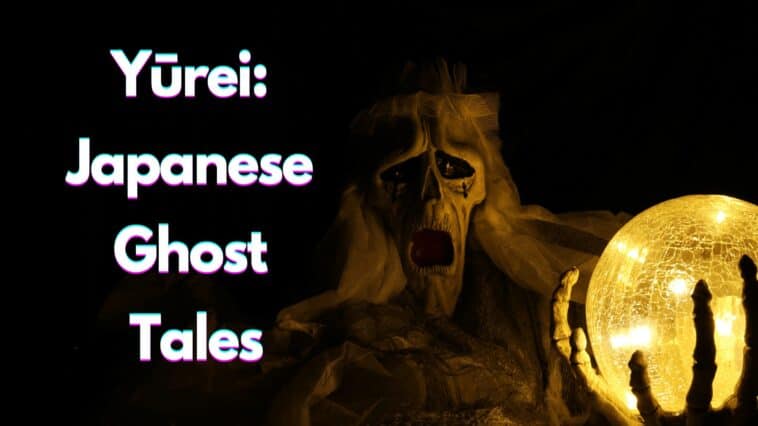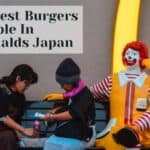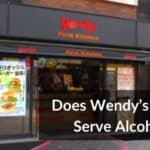Japanese Obon holidays are coming up and so it’s time to revisit the Yūrei Japanese Ghost Tales once again. Find the most popular Japanese scary folklore with revengeful spirits and ghosts
In Japan, whispers of vengeful spirits linger in the night. Prepare to be chilled by eight tales of yūrei, restless ghosts bound to the earthly realm by rage, sorrow, or a thirst for vengeance. Will their mournful cries and chilling touch keep you awake?
Page Contents
Yūrei Japanese Ghost Tales
Banchō Sarayashiki, The Dish Manor at Banchō
This is a story of the dismal fate caused by the shattered trust and broken promises. This tale is one of Japan’s Big Three Ghost Stories — Nihon san dai kaidan.

Many iterations of this story have been made and has been adapted in multiple forms of puppet theatre, kabuki, film, folk tales, and manga.
When Okiku, a humble, beautiful, and timid dishwashing servant thought she lost a plate, she made a grave, uncorrectable mistake that will be her death of her.

- Related: What is Obon? | Guide to Japanese Halloween
- Related: Guide To Japanese Halloween Obon Festival
Okiku was tricked by Samurai Aoyama, a retainer of the master at Himeji Castle because his advances at her failed. He hid one of the house’s 10 most treasured plates and blamed Okiku for it.
Worried, Okiku would spend all her time slowly and carefully counting all the plates every day. She couldn’t believe what he had done.
Aoyama said to her that he’d get her out of this distressing situation if she becomes his mistress.
Even though she wanted to live, she would do no such thing. Being driven with rage, Aoyama beat her up and threw her in the well.
Though there have been multiple versions of the story, one thing remains the same. People can hear Okiku’s trembling voice from the well, counting one to nine only.
Because she came up short of one plate, she’d let out a loud shriek and sob uncontrollably. Legends say that this was her way of tormenting Aoyama in his sleep, letting him know what he did.
This Yurei horror Japanese story is really scary and I get chills every time my grandmom narrated it to me.
Botan no Doro, Tale of the Peony Lantern
If I were to describe the story in a single word, I’d call it Necrophilia. In reality, it is much more than that. It is creepy for sure, but in some ways, it is also sad.
It is the night of Obon, people are honouring and praying for the ancestral spirits, a man named Saburo saw the spirits of Oyustu and her maid holding a peony lantern and instantly fell in love.
In the light held by the maid, Saburo and Oyutsu would show their ever-growing passions for each other every night.
Until one night, a man passing by his window saw that Saburo was weak and was lying next to a corpse.

Blinded by love and passion, Saburo forgot the entity he fell in love with was a ghost, an energy-sucking ghost.
The man told this to a neighborhood priest who then cast a bunch of charms around the house that would prevent spirits and ghosts from entering the house. Saburo knew this was right.
But every night he’d see Oyutsu waiting to be reunited with him.
Little did he know, she was a Fudakaeshi, a charm ripper. She convinced Saburo to take them off so they could be together, and he did. Along with it, he threw his wits out the door.
The next morning, the neighbours found him dead with a corpse in his arms. I believe this is one of the scariest Yurei ghost stories I’ve ever heard. I couldn’t sleep the entire night when I read about it.
Here’s a movie inspired by this Yūrei Japanese Ghost Tales. Check it out below!
Suppon no Yūrei, The Softshell Turtle Ghost
Some ghosts have targeted victims. The Suppon no yūrei are only involved in haunting those who eat, catch and sell suppon (softshell turtles) in large amounts.
The suppon no yūrei present themselves as colossal ghosts that have pointed lips and legless bodies. They hover over a man who has ingested one too many suppons.
They’re told to be tenacious and their curses are believed to be unbreakable.
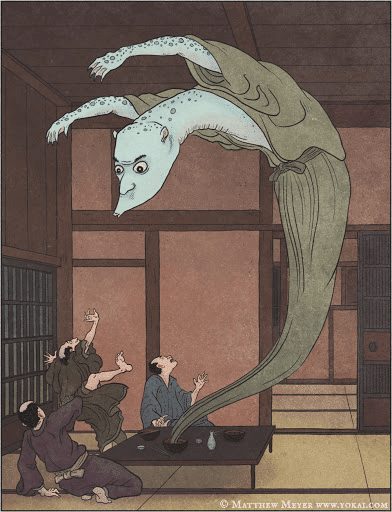
One such man, whose life depended on making a living out of selling suppons befell upon this fate. The last suppon he had manifested into a very long, 30-metre tall suppon no yūrei and haunted him thereafter.
If that curse wasn’t bad enough, the newborn child of the man looked like a suppon. Everything seemed disfigured. With greenish skin, pointy lips and hair longer than the body, it seemed as if the ghost was taunting him.
According to me, Suppon is one of the most horrific Japanese ghost yurei as it’s an animal that keeps taunting. I really got frightened to death after reading about this story.
To make it more dreadful, the baby had to be fed only worms as the turtle-like mouth prevented him from eating any normal human food.
Yotsuya Kaidan, The Ghost Story of Yotsuya
This is a story of murder, betrayal and many, many ghosts. The kaidan features onryō goats that function as grudging and vengeful spirits that survive solely on their wrath.
Yotsuya Oiwa’s marriage to Iemon, a samurai, is detested and envied by Oume, another woman who has her heart set on Iemon.
Oume wants to make Iemon hate Yotsuya, so she brings her a poisoned cream that would completely disfigure her face, she was sceptical though.
But little did we know, the cream worked too well. The sight of her face drove Oiwa to tears and in that distress, she accidentally kills herself while running with a sword towards Oume.

The story has many other murders, but this is the event that started it all.
This haunted story has been retold many times, but it is believed to be cursed. Even the person who is retelling the story is susceptible to the wrath of Yotsuya.
Even today, when filmmakers want to make a film based on this story, they visit her shrine to pray, ask for blessings and permission to proceed. No one wants to mess with an onryō.
Here’s a modern day movie inspired by this Yūrei Japanese Ghost Tales
Ubume, The Ghost of the Mother
Mothers are told to have an unconditional, omnipresent, all-knowing presence in her child’s life.
According to Japanese folklore, when a mother dies while giving birth, with or without her child, she turns into an ubume. She only has one job. To make sure her baby is safe.
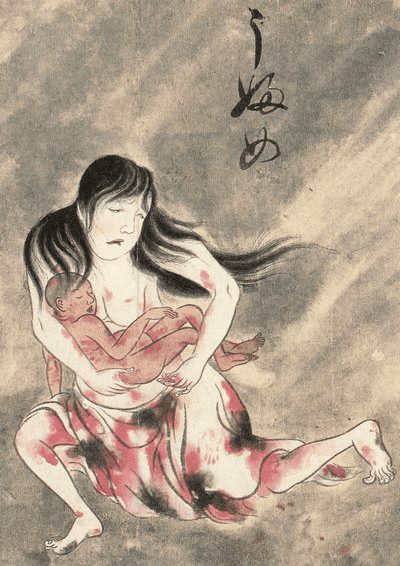
In situations where the mother died, but the baby survived, the ubume tries to ensure the well-being of her child by entering homes and ‘buying’ clothes, sweets and toys from strangers and repaying them in dead leaves.
But in cases where both the baby and the mother die in the process of delivery, the mother approaches a stranger with the infant bundled in her hands and hands it over to them.
As the ubume disappears, the bundle starts to grow heavy in their hands and they then realize that it’s a rock
Yamishi bai, The Yellow Masked Man
The anime television series released in 2013, possessing 8 seasons. In fact, the latest season only released in January 2021.
Yamishibai is a secretive, yellow-masked storyteller. Nobody knows where he is from. He is obscure and shows up at nightfall where kids assemble.
He narrates dark, scary stories based on Japanese folk stories and the more recent urban legends. Notwithstanding, the Storyteller is no common storyteller.
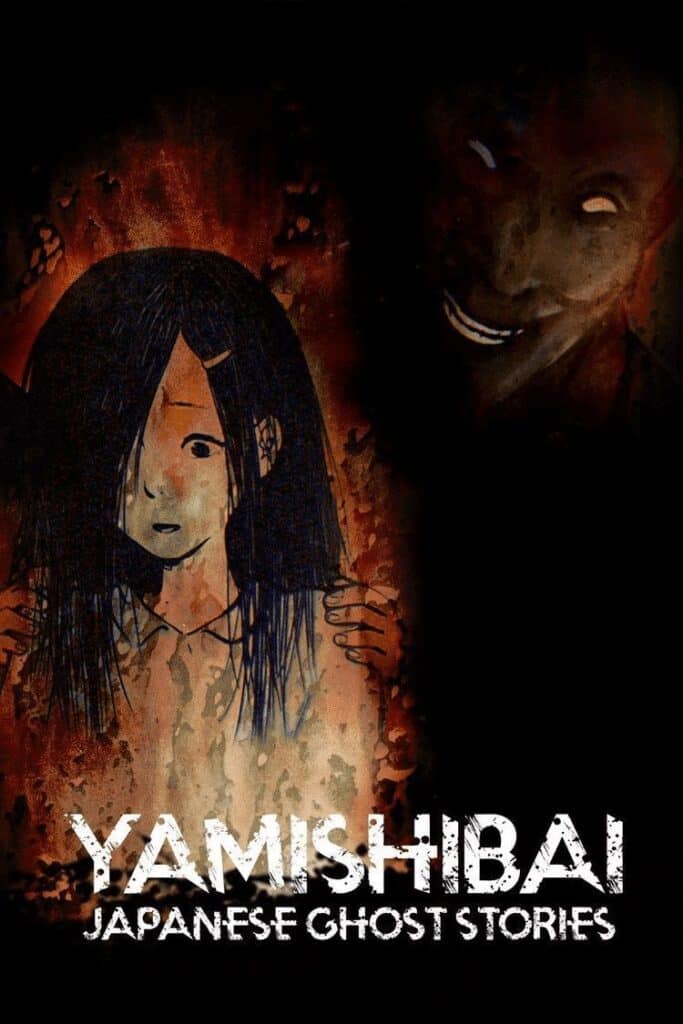
He uses a kamishibai, a traditional paper-scrolling device for showing demented visuals to his already eerie stories.
The stories begin with the tale of a man who has just moved into his new apartment. But there, lingering, he finds a single talisman who he later finds out is the savior to his eternal doom.
Every story is additionally unnerving, all the more shocking, and more nauseating than the last as the storyteller’s crowd ends up being sucked into the horrendous universe of his words.
Check out this Yūrei Japanese Ghost Tales below!
Funayūrei, The Ship Ghosts
It’s not fair, to be stranded in the middle of the sea, and because of no fault of your own, you’re taken into the depths of the sea because of a large wave, an enemy attack or a tsunami.
Naturally, the drowned sailors who lost their lives in such an event crave for vengeance. These appear luminescent mist-figured ghosts in an attempt to find their friends, comrades and other sailors who survived.

The Funayūrei ghost is strong, demanding and headstrong. They have different ways of letting their wrath go.
Instead of attacking the ship as a crew of man-sized hosts, they amalgamate themselves into one large body and attack the ship so sharply, that it overturns.
You do not want to take a water ferry in Japan if this haunts you. Carry a life jacket anyway.
Goryō, The Honoured Ghost
The goryōs haven’t heard of subtle. If they act, they act in ways the entire town will notice.
If you’ve wronged a man and he returns as a goryō, a ghost that thrives on vengeance, you’ll be rewarded with fires, wars, plagues, droughts, floods, storms, and lastly deaths.
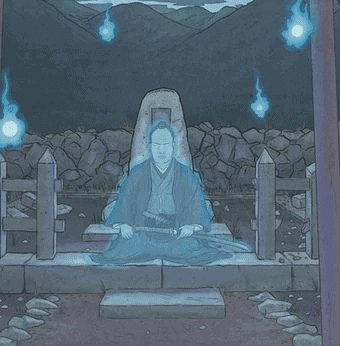
The goryōs seem to think they’re entitled to such a massive action, because, during their lifetime, they were notable members of the community who had been wronged.
They’re ghosts, so they cannot be killed. But the calamities that are cast needed to be ended.
So with the help of some priests, after heart-felt praying, the ghosts were turned into benevolent and undisturbing creatures.
Are Yurei ghosts always females?
No, Yurei ghosts can be male or female. However, in traditional Japanese ghost stories, the vast majority of Yurei are portrayed as female. There are a few possible explanations for why this is
First, it could be because women were traditionally seen as being more emotional than men, and thus more prone to becoming ghosts after they died.
Secondly, it could be because women were often denied proper funerary rites and sometimes even killed after their husbands died (in order to prevent them from marrying again), which would make them more likely to become angry ghosts seeking revenge.
Finally, it could simply be because most Japanese ghost stories were written by men, and thus they tended to focus on female Yurei.
What does yūrei mean in Japanese?
The word “yūrei” is written using two kanji characters, 幽霊. The first character, 幽, means “faint”, “dim”, or “lightless”. The second character, 霊, means “soul” or “spirit”. So together, the word can be translated as either “ghost” or “spirit”.
What is the difference between yōkai and yūrei?
Yōkai are creatures or supernatural spirits that are often mischievous, but sometimes helpful. Yūrei, on the other hand, are ghosts of the dead. They’re usually portrayed as being kind and gentle, but can also be vengeful.
Are Japanese yūrei stories real?
Yūrei can be interpreted in many ways. Some people believe they are supernatural beings, others think they are the spirits of the dead, and still, others believe they are manifestations of a person’s emotional state.
There is evidence that some people in Japan have believed in yūrei for centuries. For example, there are paintings of yūrei from the 18th century and reports of people seeing yūrei from the early 19th century.
Also Read:


